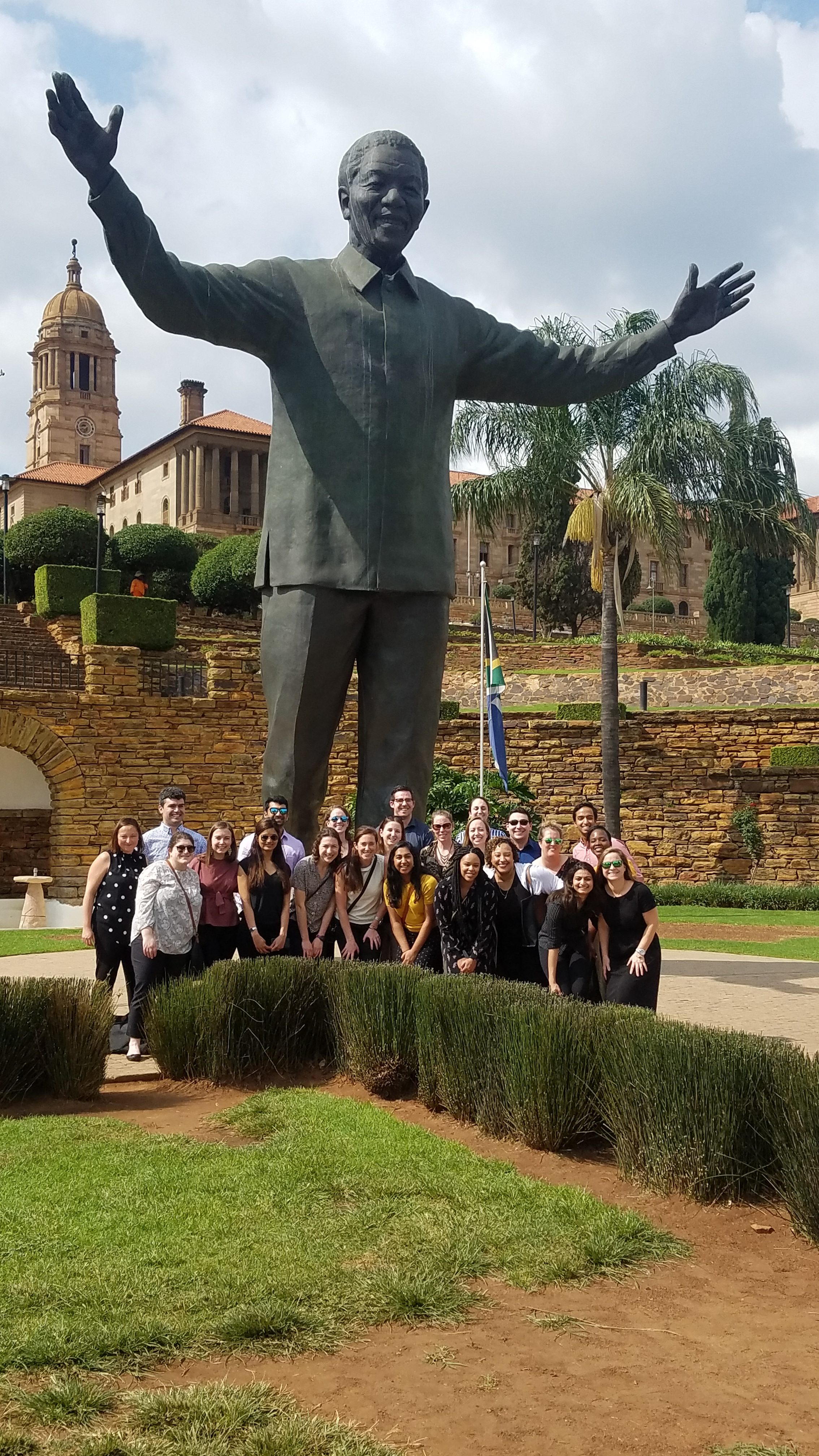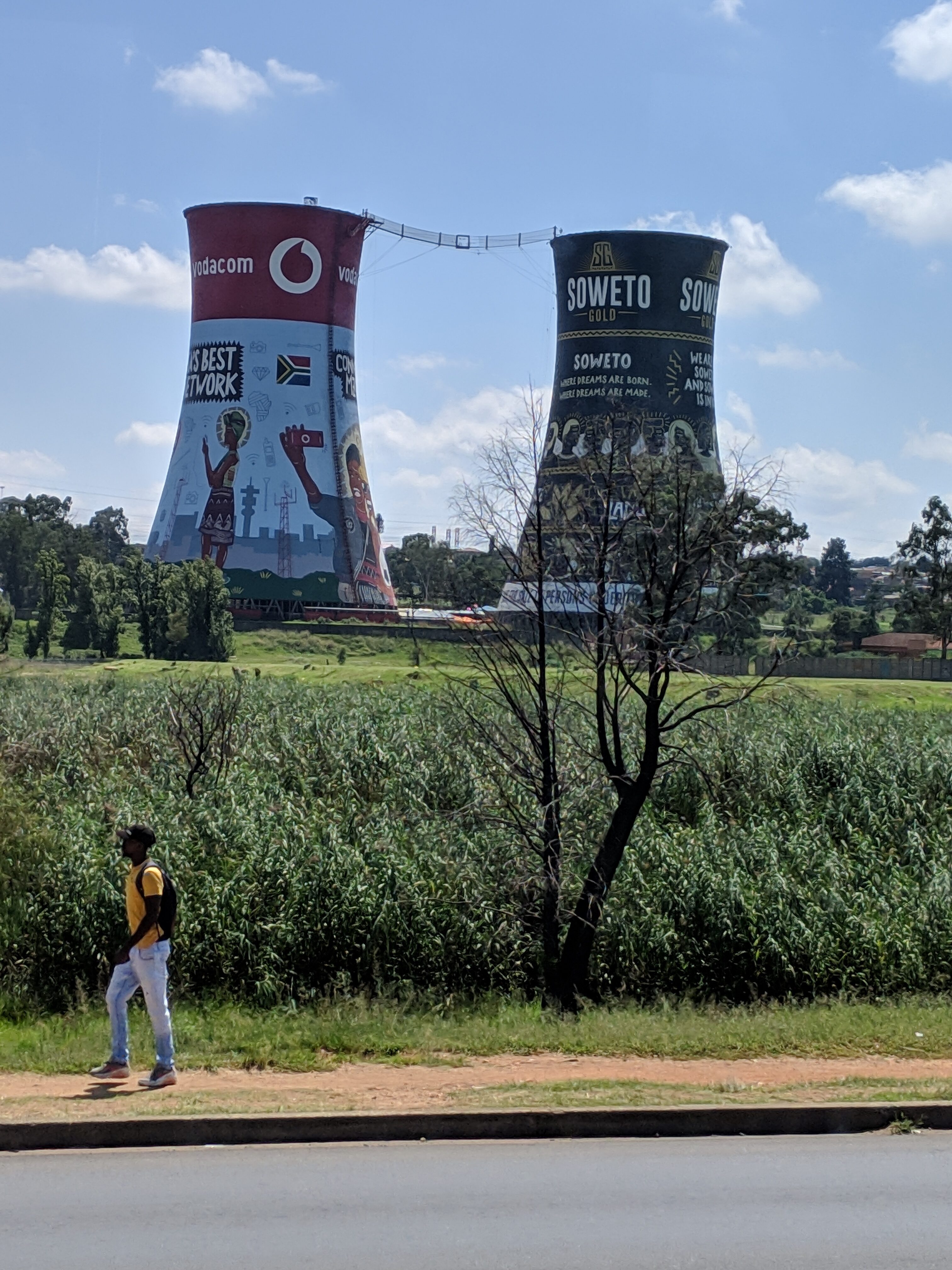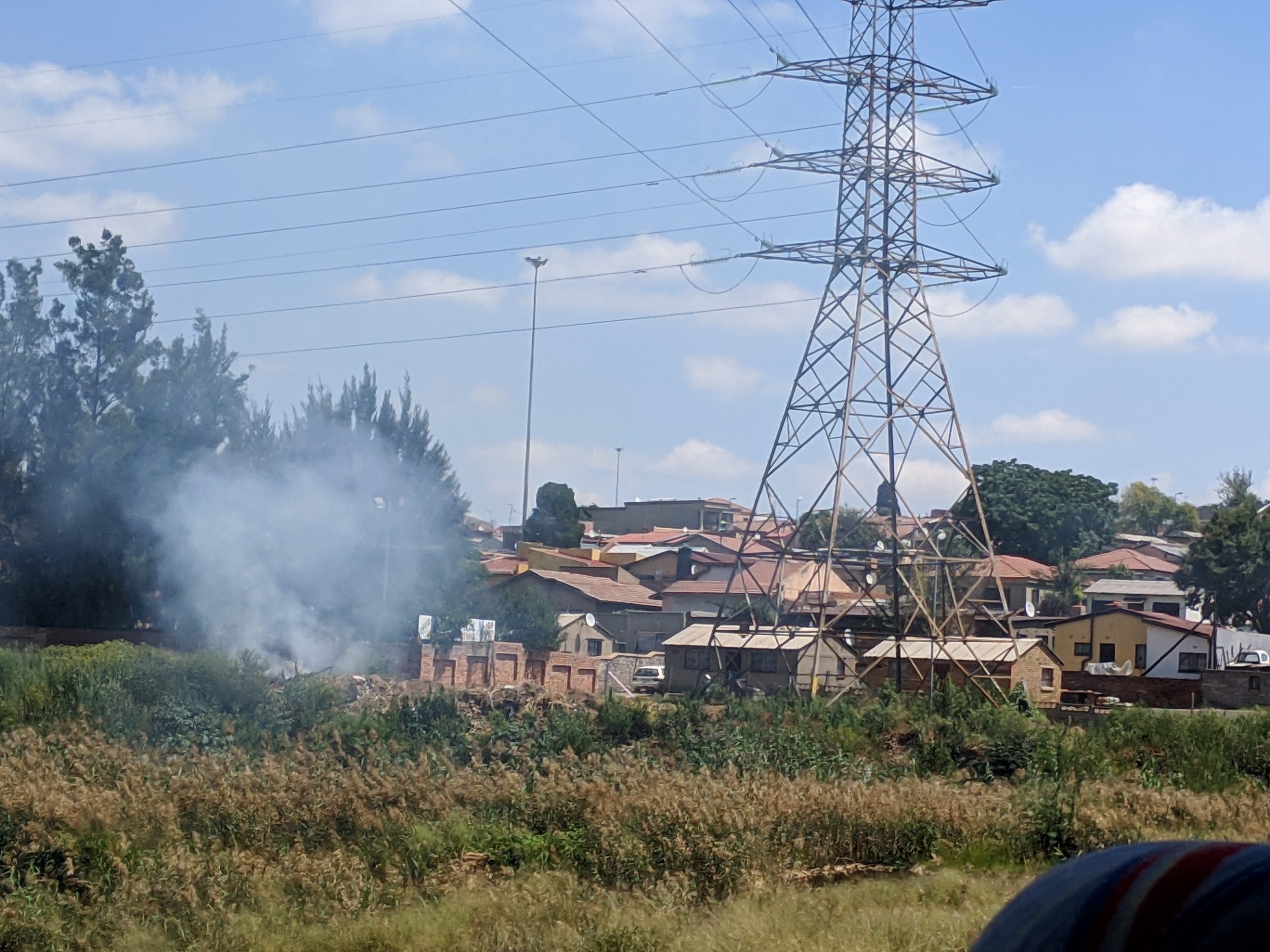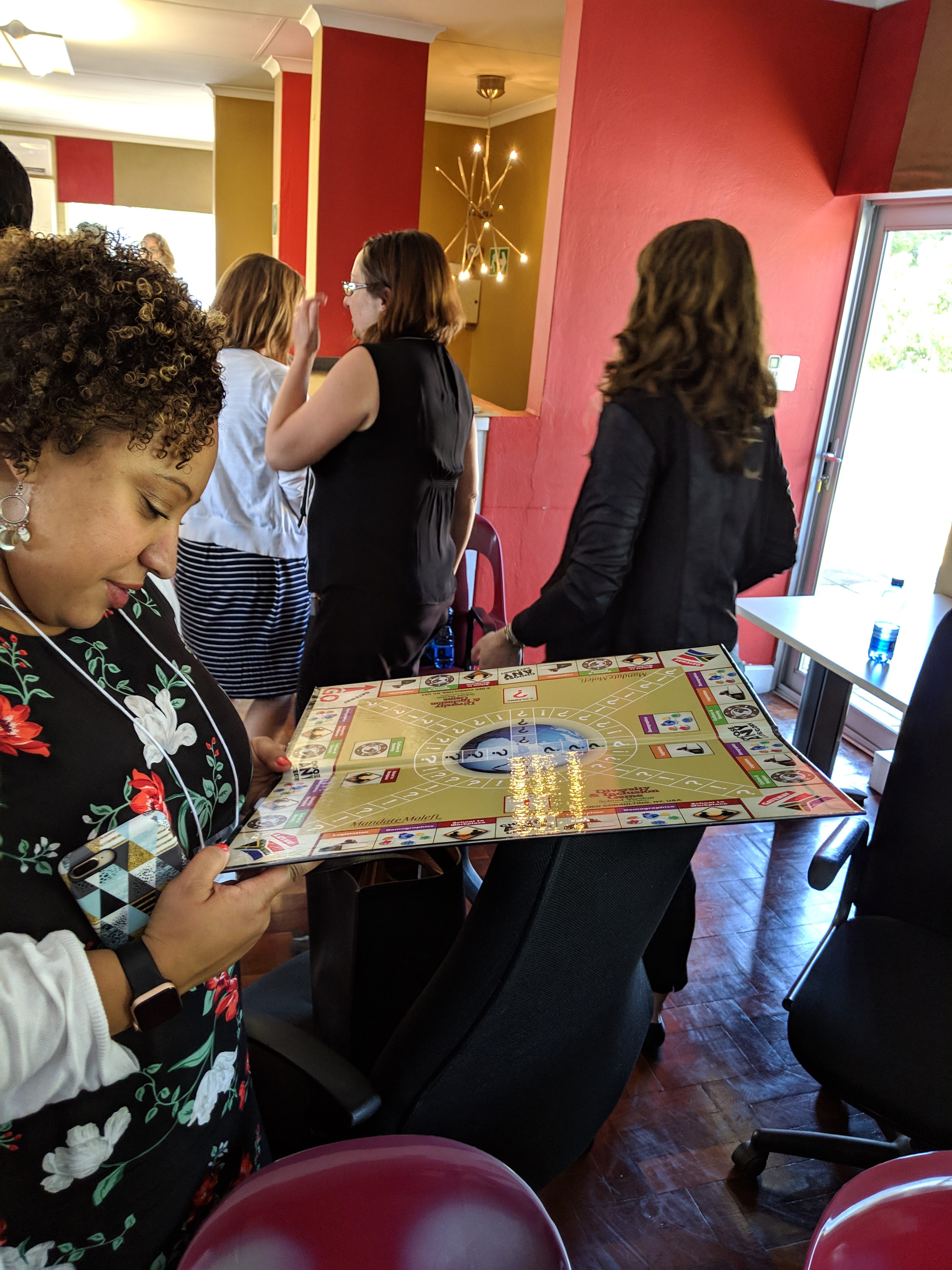South Africa (Spring 2019)
Student participants in the Social Impact Field Seminar 2019 South Africa share their reflections on their learning experience in the below blog posts (unedited)

Investing and creating jobs in South Africa
By Joye
There is great opportunity here; it’s a matter of getting passionate people who love this country to invest in it and create these jobs.

One of the things that I had been told before coming to South Africa was to be careful of crime. I wondered how much was fearmongering and how much was real. When we got on the bus to visit our first destination in Johannesburg, the thing that struck me was the gates and barbed wire surrounding every building. This sort of security extended to both homes and businesses. One of our site visit hosts was an American expatriate and he said that he got used to almost everything about Johannesburg, but it is still not accustomed to having a nice house but then having to have a wall around it. High crime is a carryover from apartheid, which created a vast socio-economic divide between groups in addition to the racial one. In multiple cases, black people were forced out of their homes and sent to live in townships. One of the other policies of apartheid was that certain groups had priority in getting jobs. Even jobs that white people did not want, such as factory jobs, were often set aside for “coloured” people first, before black people. These sort of policies contributed to the vast unemployment we still see today: 28 percent. With nearly a third of eligible workers unemployed, it explains why we so often saw groups of people hanging out on street corners, on grassy spaces, etc. apparently idle. I would often look at them as we drove past them on the bus. Sometimes I’d walk past them on the street. With no full-time job, where are these people going to go? What else are they going to do? It’s not a matter of laziness, there are simply no jobs for them. In addition, many of the people who do have jobs are underemployed. The unemployment rate also made me think about some of the problems that go along with unemployment. Obviously, crime is one of them. Having no job and no income can cause people to become desperate. I also wondered if there were drug problems, similar to the opioid crisis in the U.S., which sees peaks in areas with high unemployment. Having no job can set off a domino effect to a variety of other issues that can affect a whole society. I did not realize how high the unemployment rate was until I got here, and it’s one of the major problems that companies, government agencies, and NGO’s are tackling.

Secha Capital is one of the companies working on the unemployment problem. They call themselves an “impact investing” firm, which is debatable. However, they define themselves as making an impact because they create jobs for South Africans, and that is indeed important. The project we are working on for Nepad Business Foundation, involves creating a green circular economy for a mining region, as the coal mines are starting to run out of coal and are closing. Nepad had informed us that creating jobs was their top priority. In talking to them, they stressed the urgency of the matter. After seeing the situation firsthand, I understand why. With almost a third of the potential workforce unemployed, and many more about to become unemployed, the country faces a crisis. South Africa is considered an emerging economy, but if no new jobs are created, it is not going anywhere. Most of this workforce is unskilled labor, which adds another layer of complication. What is uplifting is that Secha Capital and Nepad Business Foundation, among others, are working to create these new jobs. Other companies, such as Mandate Molefi, are working to make sure that people that are seeking jobs are not discriminated against in the hiring process and those who have jobs are treated fairly at work so that they can stay in the workforce. It is inspiring to see so many people working to address this problem. There is great opportunity here; it’s a matter of getting passionate people who love this country to invest in it and create these jobs.

Barriers
By Laura
The physical walls that tell you to worry, and the invisible barriers that tell you what you’re allowed to choose.
One of the first things I noticed about Johannesburg was the walls. There are walls around all the houses and fences in front of all the buildings. Spikes topped all the iron gates and barbed or electrified wiring reached over top of the walls. The hostile design across the urban area is clear. Unless you’re known and invited, you will not get past those walls.
The physical barriers are for safety, but also communicate that you have reason to fear. Safety is not a given. As we drove through the high end neighborhoods of Pretoria, walls surrounded the first floor of the luxurious homes we passed and security companies advertised their home alarm and armed response services. People walked on the sidewalks outside, but it illustrated a concern for what could happen, what the owners maybe expected to happen.
I learned that Johannesburg has a mall culture because once you're inside a mall, you know you're safe to walk around. Some of the better restaurants are in shopping malls. Security guards stationed at the entrances allow shoppers to feel safe to browse.
The urban landscape echoed the invisible barriers we also saw in Johannesburg through our company meetings and tours. Our white tour guide kept repeating that after the end of Apartheid, everyone had "freedom of choice" for where they wanted to live. No one was officially segregated into neighborhoods. She suggested that some black families had moved to white areas, but decided to move back to the formerly officially segregated area of Soweto because they missed knowing their neighbors. Very few white people had chosen to move to Soweto, which still features corrugated metal houses clustered together. We didn't discuss how choices can be limited - by finances, by opportunities, by culture. You may choose to live in a nice house with electrified fencing around it, but there is a lot of history that put you in a position to make that choice.
I kept thinking back to Arc of Justice by Kevin Boyle, one of the books I read for an American history course in undergrad. Boyle examines the life of Dr. Ossian Sweet, a black physician who moved with his family into a white section of Detroit in the 1920s. Soon after the Sweet family arrived, a mob surrounded their house. Someone fired into the crowd, and soon Dr. Sweet was on trial for murder. It's a fascinating history that explores the Great Migration and interwar race relations in the north. Several years later, I attended a lecture Professor Boyle gave. He spoke about his parents, who lived in Detroit and watched their neighbors start to move to the suburbs as part of white flight from the city. In my memory - it's been almost five years at this point, so this is not a direct quote - he said that what drew him to Dr. Sweet's story was the decision his own parents made to sell their house and move. He wanted to understand what made people make the wrong choice.
Barriers remained a theme for me during our week. When we visited a research institute dedicated to HIV prevention and treatment, we learned that many young people avoid getting tested for HIV because they don't want to face the judgement of the nurses. Especially people in their late teens, who will be shamed for engaging in sexual activity, or young men, who will be stigmatized for assumptions about their sexual activity. Even if they know that they should get tested, people are reluctant to knowingly deal with that shame. When we learned about efforts to end TB, the researcher noted that stigma surrounding the disease also keeps people from wanting to get tests and treatment.
As we drove past the walled homes and businesses around Johannesburg, and later as our AirBnb host in Cape Town showed us the house's multi-level security system, I kept thinking about those barriers. The physical walls that tell you to worry, and the invisible barriers that tell you what you’re allowed to choose.
Days in Africa
By Rahul
Prologue
After more than 24 hours of flying, I arrive on the African Continent. South Africa. Or as Bunty from Eaton refers to it ," Africa - lite" . We arrived at Cape Town , via Johannesburg . I realized I had over a liter of water in my bag when I went through security, it turns out there is no liquid limit while travelling locally. Most of the travelers on our flight were bicyclists entering Cape Town for a 109Km bicycle race.
Too exhausted to do much on day one we decided to just check our the mall next door and it looked better than stores in the US. Johannesburg was going to be a different experience.
Days of JoBurg
Day 1 introduced the topic of investment , entrepreneurship and education. Talks with the partners team from Secha Capital showcased some of the efforts to increase domestic investment. Though South Africa has a wealth of natural resources and having the 2nd largest economy in the continent, it seems to have very little investment in SMEs. SMEs are required to build growth from below allowing people in the lower income brackets rise. The talks also highlighted how dependence on foreign investment is risky as the change of political situations or perceptions would cause a dramatic loss in investments.
The trip to Room to Read the speaker spoke about efforts made to increase access to book to improve the literacy of children in their native languages. This topic has been a major touch-point in my home country. Similar to India, there are around 11 official languages in South Africa. It is essential to preserve the culture of the local population, yet it is also important for people to be able to communicate in a common tongue for business. Starting in the mother tongue and moving to English seems like a logical progression but I still question the viability of teaching every child in his/her mother tongue. The minimum cost of setting up a library and its maintenance may be too much for the villages where it is needed. Additionally the cost to procure books once the trial period is over may be quite large considering the authors have to write books for a very small customer segment. Additionally the local language books I saw were very high quality and colorful , which is required to interest children, but this adds to the cost.
With all this in mind, it is a very good attempt at trying the customize the development of children rather than a mass education system.
Day 2 was spent on energy. In my time in South Africa, I noticed so many buildings running solar electric and heating panels. I was under the assumption that there wasn’t enough usage of solar energy which was how we went about the project with Eaton. The issue seems to be more on the side of funding.
South Africa in the past five years has been facing drastic increase in electricity tariffs with shortage of electricity leading to power outages /load shedding. This is due to the aging infrastructure which has seen no investment to maintain, the political motivation to keep the tariff artificially low and the corruption within the state owned power company ESKOM.
Our team presented its findings to the client and had a conversation with the those involved in the project as well as some of the vendors . Though our models were interesting it seemed like they already employed various software to make instant sophisticated models. They asked us to look more into how to make the technology more acceptable to their customers.
Day 4 was used to highlight South Africa's attempt to show progression away from its apartheid days. Mandate Molefi's founder Nini Molefi spent time talking about understanding the unconscious biases that managers have while hiring or working with someone. With every country and company facing different issues, a company can only grow if it has ideas and voice from different views. Companies such as mandate Molefi attempts to analyze the work culture of companies , offices or political parties. They use this information to provide an outside view and corrections for it. They even have a game to show diversity in schools where students form groups that exclude others causing a harmful environment.
Visits to SoWeTo and the apartheid museum show us how bad the situation was in the 70s-90s. It is hard to believe such segregation existed in a post war society. But it is also partially visible in some parts of many countries in more subtle forms. Preferential job treatment to those of similar race, depiction of colored people in movies, feelings towards people of different religions and caste based issues in India are still experienced today. Apartheid was just an extreme government form.
Looking at how the formal segregation started, i.e. loss of jobs to certain communities causing a nationalist uprising, the right wing movements in the US , Europe and other nations should be watched else history may repeat itself.
A talk with out driver Martin towards the end of our trip painted a less than rosy picture. With initiatives to help the black community, BBBEE prevents white sole ownerships of companies and forces workforce and ownership to be primarily black. It becomes harder for the white minority to find jobs. Additionally in a personal situation to him, it is common for the police to side with a black person in a physical confrontation. This was what he termed "reverse apartheid". EFF party leader Julius Malema openly campaigns with his views that whites and possibly colored people should not remain in south Africa. His posters paint the city billboards in blood red.
Our final Day was focused on healthcare with trips to WHO and Wits RHI( Reproductive health Institute)
Representatives of the WHO South Africa office spoke the efforts made by WHO to improve overall health not only physical but also mental and social. Though this is a holistic approach, I believe that it may dilute efforts and focus. Though all the sustainable development goals are important, some may be more important than others and may overlap with other organizations. The speaker also spoke about how governments should try to improve their tax models to include healthcare to promote equality and eventually the economy.
The other speaker spoke about jobs and internships at WHO. Though very interesting, many of these internships are non funded.
The final speaker spoke about TB and how HIV gets the most amount of attention but TB is just as dangerous. Luckily South Africa uses rapid testing technology to quickly test for TB and that has helped identify those in need. Additionally TB care is free for all in South Africa. This is needed to improve the community immunity.
TB may be the next major disease that the world will focuses to eradicate as it has with small pox and polio.
The Speakers at RHI were more highly focused on HIV. With improving access to HIV tests and clinics, they have identified over 90% of the HIV population. This is a great feat but is only useful if they can get this population into treatment. With the social stigma of HIV , much of the population especially males avoid treatment centers. This makes it harder to control the spread of HIV. HIV in South Africa is a major problem as with much of Africa. Improved access to drugs and efforts from the government have improved the survival of those infected but much effort has to be made to reduce its numbers. Setting goals such as 90-90-90 may be a great idea to motivate researchers and government efforts along with funding but it is far from enough.
Impact investing
By Luke
I consider it very valuable that they are able to provide the same returns as any other private equity fund while providing a key service to small to mid-sized business owners in South Africa.
As someone with a background in the investment world, I came in very interested in our first company visit with Secha Capital. Most of my experience was with traditional investment companies, so I was excited to learn about how the mission and tools of an impact investor might differ. The team brought a lot of energy in the room and talked about how they believe that their returns would equal those of any traditional private equity company and their investors wouldn’t need to take a discount by investing in an impactful cause. If that was the case, I was expecting there would be no shortage of investors as they would be able to attract both the profit maximizing and the socially conscious investors. In the US, most impact investment funds deliver a slightly lower return than traditional funds, but their investors aren’t looking for the greatest return, but rather some financial return with a large social or environmental impact.
It became clear to our group that the definition of impact investing we were operating off differed from theirs. They weren’t really providing the exact same services to society that you would see with US impact investors. I thought a lot about this the rest of the trip and came away with the conclusion that they are providing a valuable service to society. With less efficient markets than in the US, small to mid-sized businesses don’t have access to capital as easily as they do in the US. So while a private equity firm that partners with small to mid-sized businesses wouldn’t be considered impact investing in the US because they could easily find another source of money if a Secha-like firm didn’t exist, that isn’t the case as much in South Africa. I consider it very valuable that they are able to provide the same returns as any other private equity fund while providing a key service to small to mid-sized business owners in South Africa. Maybe impact investing isn’t the best label for Secha Capital at this point, and if they choose to expand their scope, there will be no shortage of opportunities for them to do so. However, I considered our visit to Secha Capital to be an excellent one to start out with, highlighting for us the fact that South Africa was not that different a place to operate a business as one might think from the US. The same conversation we were having in that room could’ve been happening in any city in America. For a lot of Americans coming to Africa for the first time, they build it up in their head as a place with a totally different set of rules and customs. This set us off on the right path in considering these visits to be with just as sophisticated a company as you would find in the US, just with a slightly different context.
Inspired to help developing solutions that can change the world
By Madeline
I have never been more certain that social impact and sustainability focuses are the most important thing to create a meaningful life for myself and others. Overall, this trip was incredibly impactful and motivating for me to continue travel, learn through experience and personal interaction, and help in developing solutions that can change the world.
My time in South Africa felt very conflicted between such a beautiful country and beautiful people and such a horrible past. The first half of the week was somewhat light, punctuated with glimpses at the torrid past that affected most of the population of the country. Monday’s visits to Secha Capital and Room to Read were very different. Secha Capital felt more familiar to me, working in the investment world, and being from the town next to co-founder, Brendan’s hometown. Room to read felt like a true nonprofit doing incredible work in the townships around Johannesburg. The second day was again familiar and business focused. Our site visit was to Eaton, as was our consulting project. Our group was hard at work to pick up any last-minute information from the tour and presentation on load shedding and microgrids. Load shedding was a subject that I had learned in theory while researching for Eaton, but in practice seemed to be a challenge to get used to. There are so many luxuries that power provides that I seem to have taken for granted: charging my phone, having a working stove, and working lights, to name a few. This is a serious problem that seems to have only been made worse by corruption. However, the people we met with and the work that we did with Eaton makes the situation seem hopeful and promising.

On Wednesday, the mood flipped for me. Our first visit to Mandate Molefi was inspirational and seemed to be very in line with other diversity and inclusion practices that I have seen in the United States. However, visiting the Apartheid museum and Soweto changed the business and opportunity focus of the trip thus far to South Africa’s darker past. While I knew who Nelson Mandela was and some of the history surrounding apartheid, I was not prepared for the overwhelming disappointment in humankind that I felt after these visits. Despite the encouraging Mandela exhibit at the museum, I left with a heavy heart. Something that I was most struck with was the recency of the change. This meant that a majority of the people we had met earlier in the day in Soweto and Johannesburg had lived through the horrific events detailed in the museum.
While the safari on Thursday flew by, Friday was back to serious and heart wrenching material with a visit to the UN and WITS HIV prevention center. Seeing the incredible work that the doctors, researchers, operations team, etc are doing to change lives on a daily basis made me feel both overwhelmed at the amount of work to be done and incredibly hopeful that such amazingly smart people are at work here. Thinking about my career going forward, I have never been more certain that social impact and sustainability focuses are the most important thing to create a meaningful life for myself and others. Overall, this trip was incredibly impactful and motivating for me to continue travel, learn through experience and personal interaction, and help in developing solutions that can change the world. I have developed memories and relationships that won't be soon forgotten.
